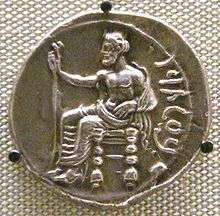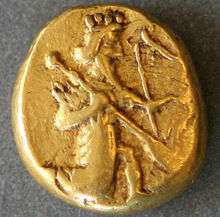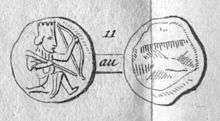Achaemenid coinage

Coins of the Achaemenid Empire were issued from 520 BCE-450 BCE to 330 BCE. The Persian daric was the first gold coin which, along with a similar silver coin, the siglos, (From Ancient Greek σίγλος, Hebrew שֶׁקֶל (shékel))represented the bimetallic monetary standard of the Achaemenid Persian Empire which has continued till today.[1] It seems that before then, a continuation of Lydian coinage under Persian rule was highly likely. Achaemenid coinage includes the official imperial issues (Darics and Sigloi), as well as coins issued by the Achaemenid governors (Satraps), such as those stationed in ancient Asia Minor.
Daric


Darius first introduced a reformed currency system at about 520-480; the precise period is debatable. The rate of exchange was 1 Daric = 20 Siglos. It consisted of a Daric of between 8.10-8.50 grams in weight and based on the Babylonian shekel of 8.33 grams. The purity was between 98-99% gold.
After the capture of Babylon by Alexander, the Satrap Mazaeus issued the double Daric of 16.65 grams in weight whose image was based on the Daric coin and bore his name until his death in 328 BCE. 1 Daric = 25 Attic Drachmae.
Siglos
Siglos is 5.40-5.60 grams each, but is based on the 0.5 Lydian Siglos of 10.73-10.92 grams for the full unit. Purity was at first issue 97-98% but by the middle 4th century was 94-95%. 1 Siglos = 7.5 Attic Obols
Archaeological finds
Daric coins have been found in Asia Minor, Greece, Macedonia and Italy. The Siglos denomination have been found in hoards only in Asia Minor, and single coins with other Greek coinage from Ancient Egypt to Afghanistan and Pakistan, making it an important issue for the region.
See also
References
- ↑ Michael Alram, "DARIC", Encyclopaedia Iranica, December 15, 1994, last updated November 17, 2011
- Zeno coins of Iran
- Daric information
- Money weights and measures in Antiquity including Babylonian
- Persian coins and Satraps coins
- Asia Minor Coins - Achaemenid Satraps and Governors